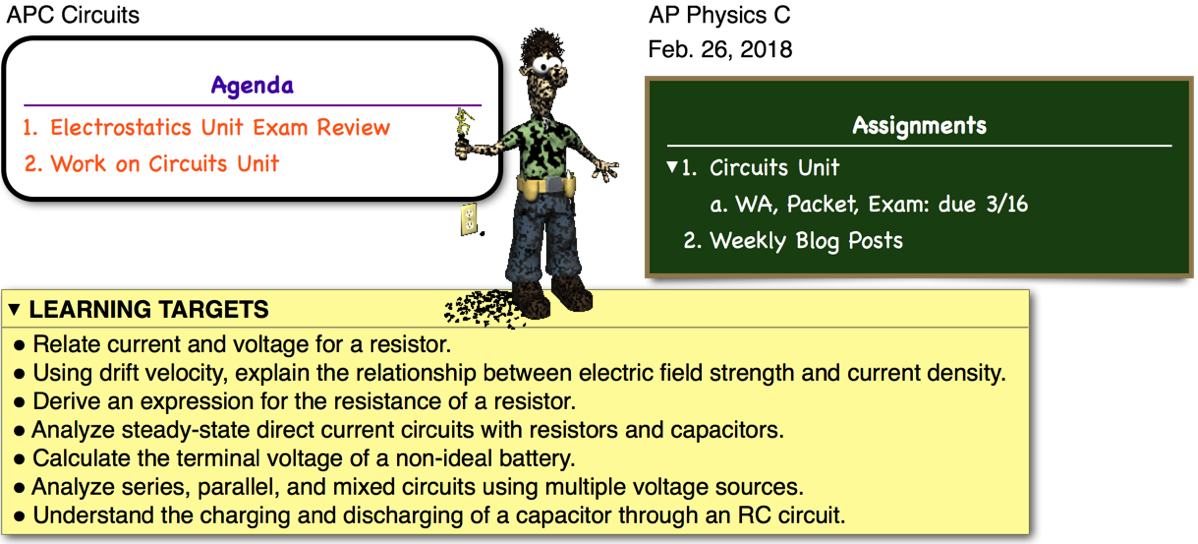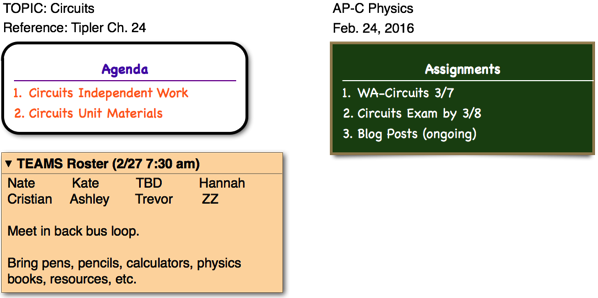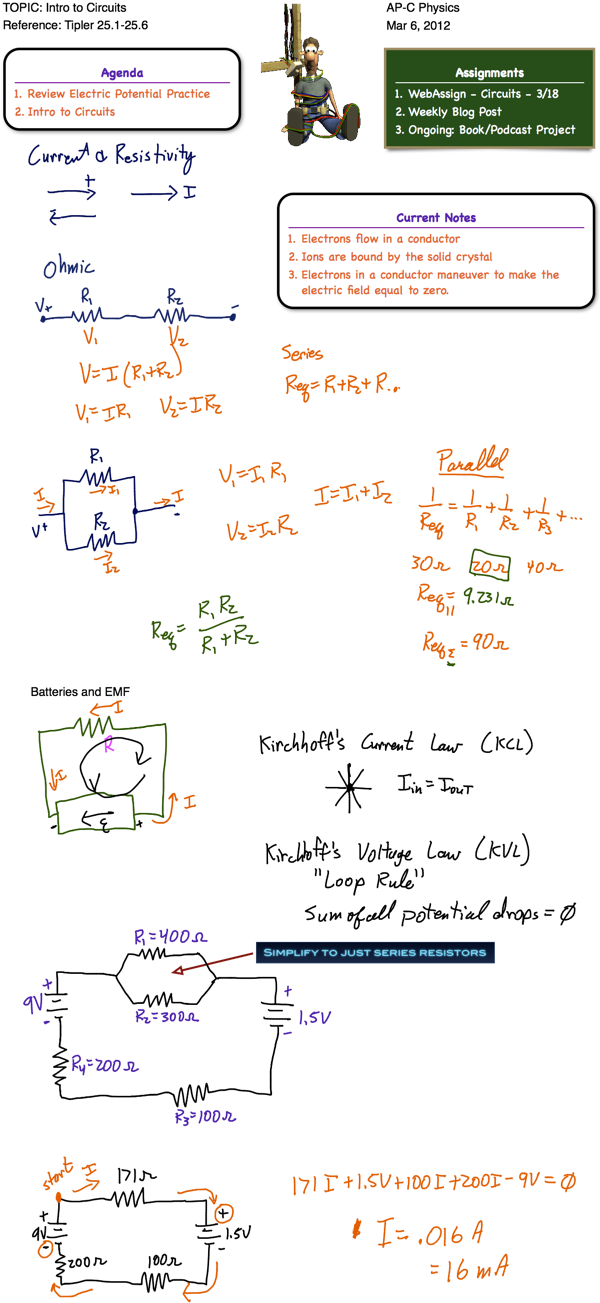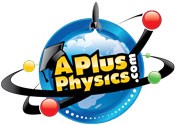
Tag Archives: Circuits
Electric Circuits Finale

Circuits Exam

Circuits Work Time

Intro to Circuits

AP Physics C Independent Unit: Circuits
The circuits unit is largely a review of circuit analysis from your previous algebra-based physics course, with the addition of a few calculus concepts and slightly more involved analysis requirements. The circuits unit will be presented as an independent unit, with students expected to manage and utilize both in-class and out-of-school time appropriately in order to turn in all deliverables at the beginning of class on the due date specified.
- Read textbook Chapter 25. Work through examples 25-1, 25-2, 25-7, 25-16, 25-17, 25-18, and 25-19. Turn in neatly organized work for these problems.
- Watch all APlusPhysics AP-C videos in the “Circuits” section.
- Watch Walter Lewin MIT 8.02 Physics Videos (Spring 2002) Lectures 9 & 10.
- Complete WebAssign problems, showing all work “WA-Circuits.”
- Complete the NASA “Space Shuttle Short Circuit” activity (teams of 2-3).
- APC EM FR Problems 2010#2, 2004#2, 2007#1, 2003#2, 2006#2 and achieve a score of 100% (answers available to check your work).
- Complete the “Measuring Capacitance” Lab (teams of 2-3).
- Complete the C Current 2007 practice exam and score 100% (answers available to check your work).
- Make Your Own SimuLab to assist students in exploring RC circuits.
- Catch up on your APlusPhysics blog posts (target is one per week), comment on at least one other blog post per week, and rate at least three blog posts. If you’re searching for topics, examining the parallels of RC circuits and free fall with retarding forces is a great way to begin.

Due: 3/7/14
You may work alone or in groups, and the order and scheduling of your activities is completely up to you. Prior to class on exam day (specified above), you are to place your work for items #1, and 4-9, all stapled together with your name, in the INBOX.
I will be available for guidance if you get stuck, but recommend you utilize the available resources (including each other) to help you independently first. These resources include, but are not limited to:
APlusPhysics videos and unit guide sheets
Walter Lewin / Hippocampus videos
LearnAPPhysics.com
Physics Forums HW Help: http://aplusphysics.com/forums
Create a Capacitor SimuLab
Ref. Tipler Ch. 25.1-25.6
- HW: WA-APC-Circuits 3/18
- HW: Capacitor SimuLab 3/26
PURPOSE
Using the capacitor simulation at http://phet.colorado.edu/en/simulation/capacitor-lab and the
AC/DC circuit construction kit at http://phet.colorado.edu/en/simulation/circuit-construction-kitac,
you and your team are to create a simulation lab for future AP-C Physics Students. This lab
should include a purpose, detailed step-by-step procedure, data tables, and appropriate
analysis questions to help students develop an understanding of the key learning objectives for
this activity.
KEY LEARNING OBJECTIVES
- Describe qualitatively and quantitatively the patterns and variation of the electric field
between oppositely-charged parallel plates. - Understand the relationship between capacitance, stored charge, voltage, stored energy,
area, separation distance, and dielectric constant for a parallel plate capacitor. - Calculate the equivalent capacitance of a series or parallel combination of capacitors.
- Determine the ratio of voltages for capacitors connected in series.
- Calculate the voltage or stored charge, under steady-state conditions, for a capacitor
connected to a circuit consisting of a battery and resistors. - Sketch or identify graphs of stored charge or voltage for the capacitor, or of current or
voltage for the resistor, and indicate on the graph the significance of the time constant. - Write expressions to describe the time dependence of the stored charge or voltage for
the capacitor, or of the current or voltage for the resistor.
DELIVERABLES
1. One completed lab handout, neatly typed and organized in such a fashion that it could
be immediately handed out to other AP-C physics students for in-classroom use without
further modification. Do not place your names on this copy, but instead attach your
names to it using a yellow sticky note.
2. A second copy of the lab handout, this copy having been filled out completely as if you
were a student working through the lab, and at such a quality level that it can be used as
an answer key. It is to be labeled as “Teacher’s Guide.”
3. Do not staple any of your deliverables. Paper clips will be provided upon request.
 RESOURCES
RESOURCES
- Teaching Ideas available at http://phet.colorado.edu/en/simulation/capacitor-lab.
- Teaching Ideas available at http://phet.colorado.edu/en/simulation/circuit-constructionkit-ac.
- The circuit diagram at right is a great place to start for use with your RC circuit analysis.
- Your textbook and notes.
Circuits Review

